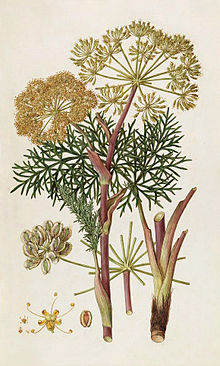| Thapsia | |
|---|---|

| |
| Thapsia garganica | |
| Scientific classification | |
| Kingdom: | Plantae |
| Clade: | Tracheophytes |
| Clade: | Angiosperms |
| Clade: | Eudicots |
| Clade: | Asterids |
| Order: | Apiales |
| Family: | Apiaceae |
| Subfamily: | Apioideae |
| Tribe: | Scandiceae |
| Subtribe: | Daucinae |
| Genus: | Thapsia L. |
| Synonyms | |
| |
Thapsia, commonly known as the deadly carrots, is a small genus of poisonous plants in the family Apiaceae. Their center of diversity is around the western Mediterranean, extending into the Atlantic coasts of Portugal and Morocco. Some species are used in traditional medicine.
Description
Species of Thapsia are herbaceous perennials, growing 50 to 200 cm high. The inflorescences are large, regularly distributed umbels. The seeds have four wings, and are the main characteristic of the genus, which is distributed in the Mediterranean, on the Iberian peninsula, and North Africa.
The generic name Thapsia is derived from the Ancient Greek name θαψία (thapsía) for the members of the genus. The Greeks believe it to have originated from ancient Thapsos in Sicily. It has a long history of being used in ancient traditional medicine. Algerians used it as a pain-reliever though they recognized that the plant was deadly to camels. The Greek colony of Cyrene exported a medicinal plant known as silphion, used as a purgative and emetic. Although its exact identity remains contentious today, some historians believe that the plant may have been Thapsia garganica.
Cancer research
The chemical compound thapsigargin has been isolated from Thapsia garganica. A synthetic prodrug of thapsigargin called "G-202" is in preliminary clinical trials for cancer treatment. The active constituent kills tumor cells by destroying their calcium balance. A biotech company called GenSpera, Inc. in San Antonio, TX is studying methods of delivering thapsigargin directly to cancer cells, avoiding damage to other cells in the body of the patient.
Antiviral research
This same chemical compound thapsigargin is now being looked at as an antiviral to use against SARS-coV-2, the coronavirus virus that causes COVID-19. It has not yet reached the clinical trial stage.
Species
20 species of Thapsia are currently accepted. It is, however, a complex genus, and some authors may recognize different numbers of species.
- Thapsia asclepium L.
- Thapsia cinerea A.Pujadas
- Thapsia eliasii (Sennen & Pau) Wojew., Banasiak, Reduron & Spalik
- Thapsia foetida L.
- Thapsia garganica L.
- Thapsia gummifera (Desf.) Spreng.
- Thapsia gymnesica Rosselló & A.Pujadas
- Thapsia maxima Mill.
- Thapsia meoides (Desf.) Guss.
- Thapsia minor Hoffmans & Link
- Thapsia nestleri (Soy.-Will.) Wojew., Banasiak, Reduron & Spalik
- Thapsia nitida Lacaita
- Thapsia pelagica Brullo, Guglielmo, Pasta, Pavone & Salmeri
- Thapsia platycarpa Pomel
- Thapsia scabra (Cav.) Simonsen, Rønsted, Weitzel & Spalik
- Thapsia smittii Simonsen, Rønsted, Weitzel & Spalik
- Thapsia tenuifolia Lag.
- Thapsia thapsioides (Desf.) Simonsen, Rønsted, Weitzel & Spalik
- Thapsia transtagana Brot.
- Thapsia villosa L.
Gallery
References
- "Thapsia L. | Plants of the World Online | Kew Science". Plants of the World Online.
- M. Seoane (1831). Neuman & Baretti's Dictionary of the Spanish and English Languages. William Clowes.
- S. Iadjel; A. Zellagui & N. Gherraf (2011). "Reinvestigation of essential oil content of Thapsia garganica grown in the east of Algeria" (PDF). Revue des Sciences fondamentales et appliquées. 2: 30–34. Archived from the original (PDF) on 2021-11-22. Retrieved 2012-08-26.
- ^ S. Castroviejo; et al., eds. (2003). Flora Iberica. Volume X: Araliaceae-Umbelliferae (PDF). Real Jardín Botánico. pp. 401–410. ISBN 8400081501.
- M. Grieve. "Thapsia". Botanical.com. Retrieved August 26, 2012.
- "Thapsigargin prodrug G-202". NCI Cancer Dictionary.
- Kristen Philipkoski (2 February 2012). "Scientists Transform Deadly Plant Into Cancer Killing Smart Bomb". Gizmodo.com. Archived from the original on 2 December 2017. Retrieved 15 September 2017.
- David Nield (27 November 2021). "Molecule Derived From Poisonous Plant Blocks All SARS-CoV-2 Variants in Cell Cultures". ScienceAlert.com.
- "Thapsia L." Plants of the World Online. Royal Botanic Gardens, Kew. Retrieved 10 September 2024.
- Pujadas-Salva, A. J.; Plaza-Arregui, L. (2003). "Studies on Thapsia (Apiaceae) from north-western Africa: A forgotten and a new species" (PDF). Botanical Journal of the Linnean Society. 143 (4): 433. doi:10.1111/j.1095-8339.2003.00233.x.
External links
- "Thapsia". International Plant Names Index (IPNI). Royal Botanic Gardens, Kew; Harvard University Herbaria & Libraries; Australian National Botanic Gardens.
| Taxon identifiers | |
|---|---|
| Thapsia | |

